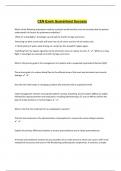CEN Exam Guaranteed Success
Which of the following statements made by a patient would lead the nurse to conclude that the patient
understands risk factors for pulmonary embolism?
While on a long flight, I should get up and walk to stretch my legs every hour.
Resuming my birth control pills will lower my risk of cancer and my risk of another clot.
If I drink plenty of water while driving on a long trip, this shouldn't happen again.
Switching from my regular cigarettes to the electronic ones can reduce my risk. ✔️✔️While on a long
flight, I should get up and walk to stretch my legs every hour.
What is the primary goal in the management of a patient with a suspected myocardial infarction (MI)?
The primary goal is to restore blood flow to the affected area of the heart and minimize heart muscle
damage. ✔️✔️
Describe the initial steps in managing a patient who presents with a suspected stroke.
Initial management involves ensuring the patient's airway, breathing, and circulation (ABCs) are stable,
followed by rapid assessment and evaluation, including administering a CT scan or MRI to confirm the
type of stroke (ischemic or hemorrhagic). ✔️✔️
What is the first-line treatment for an anaphylactic reaction?
The first-line treatment is the administration of epinephrine to reverse the severe allergic reaction.
✔️✔️
Explain the primary difference between a tension pneumothorax and a simple pneumothorax.
A tension pneumothorax involves the accumulation of air under pressure, which can cause a shift in the
mediastinal structures and result in life-threatening cardiovascular compromise. In contrast, a simple
,pneumothorax is a less severe accumulation of air in the pleural space without significant hemodynamic
instability. ✔️✔️
What is the most important intervention for a patient with a suspected airway obstruction?
The most important intervention is to clear the airway to ensure that the patient can breathe.
Techniques such as the Heimlich maneuver or endotracheal intubation may be necessary, depending on
the severity. ✔️✔️
How should a nurse assess the severity of a burn injury?
Burn severity is assessed using the rule of nines to determine the percentage of body surface area (BSA)
burned, and by evaluating the depth of the burn (e.g., superficial, partial-thickness, full-thickness).
✔️✔️
In the case of a patient with acute respiratory distress, what is the first step in management?
The first step is to ensure the airway is patent and administer oxygen to support the patient’s breathing.
✔️✔️
When caring for a patient in shock, what is the primary nursing intervention?
The primary intervention is to restore circulating volume through the administration of fluids, typically
starting with IV fluids such as normal saline or lactated Ringer’s. ✔️✔️
What are the signs and symptoms of hypovolemic shock?
Signs and symptoms of hypovolemic shock include tachycardia, hypotension, weak pulses, cool and
clammy skin, and decreased urine output. ✔️✔️
What is the purpose of using a Glasgow Coma Scale (GCS)?
,The GCS is used to assess a patient's level of consciousness by evaluating eye opening, verbal response,
and motor response to stimuli. It helps in determining the severity of brain injury. ✔️✔️
What is the correct intervention for a patient with a suspected foreign body aspiration?
The correct intervention is to perform the Heimlich maneuver if the patient is conscious and unable to
cough, or to initiate emergency measures such as suction or bronchoscopy if the patient is unconscious.
✔️✔️
How would you manage a patient experiencing a seizure?
Management includes protecting the patient from injury, maintaining an open airway, and providing
supplemental oxygen if necessary. After the seizure, assess the patient’s vitals and oxygenation levels.
✔️✔️
What is the significance of monitoring urine output in a patient with trauma?
Urine output is an important indicator of renal perfusion and overall hemodynamic stability. Decreased
urine output can suggest hypoperfusion or kidney injury. ✔️✔️
What should be the priority assessment for a patient who presents with altered mental status?
The priority assessment should focus on identifying and addressing any reversible causes, such as
hypoxia, hypoglycemia, or drug overdose, and stabilizing the airway, breathing, and circulation. ✔️✔️
What is the nursing intervention for a patient who has just been administered a narcotic analgesic and is
showing signs of respiratory depression?
The intervention includes closely monitoring the patient’s respiratory status, administering naloxone
(Narcan) if indicated, and ensuring that the airway remains open. ✔️✔️
, What is the first priority when caring for a patient with a penetrating abdominal wound?
The first priority is to control bleeding by applying direct pressure or a dressing, followed by assessing
the ABCs (airway, breathing, circulation) and preparing for surgery. ✔️✔️
How do you differentiate between a sprain and a strain?
A sprain involves injury to ligaments, while a strain is an injury to muscles or tendons. Sprains typically
present with swelling, bruising, and instability, while strains may present with muscle pain and stiffness.
✔️✔️
What are the signs of diabetic ketoacidosis (DKA)?
Signs of DKA include hyperglycemia, fruity-smelling breath, dehydration, tachypnea, and confusion. The
patient may also present with nausea and vomiting. ✔️✔️
How should you manage a patient who has ingested a toxic substance?
Management involves assessing the patient's ABCs, initiating gastric decontamination if indicated (such
as activated charcoal), and administering antidotes if appropriate. ✔️✔️
What is the role of the nurse in managing a patient with a suspected spinal cord injury?
The nurse should immobilize the spine, ensure the airway is open, and monitor the patient’s
neurological status and vital signs while preparing for transportation to an appropriate care facility.
✔️✔️
What should be the nurse's priority when caring for a child in respiratory distress?
The priority is to maintain the child's airway, provide supplemental oxygen, and observe for signs of
further deterioration, such as changes in respiratory rate, effort, and color. ✔️✔️




